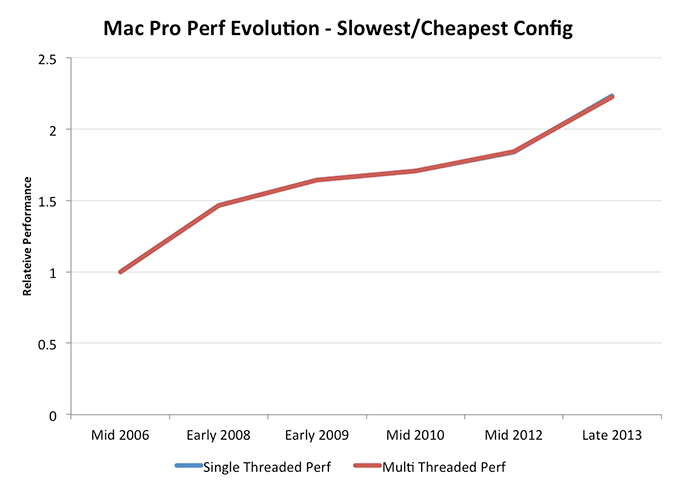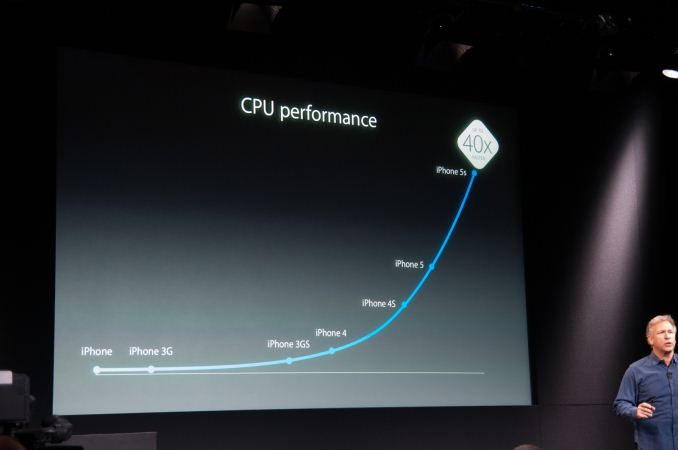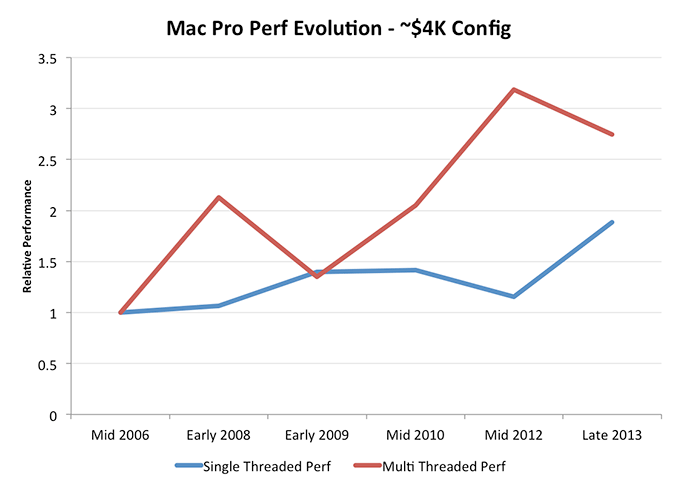The Mac Pro Review (Late 2013)
by Anand Lal Shimpi on December 31, 2013 3:18 PM ESTSetting Expectations: A Preview of What's to Come in Mobile
Sitting in the audience at the iPhone 5s launch I remember seeing this graph showing iPhone CPU performance increase since the first iPhone. Apple claimed a 41x increase in CPU performance if you compared the Cyclone cores in its A7 SoC to the ARM11 core in the first iPhone. What’s insane is just how short of a time period that comparison spans: 2007 - 2013.
I ran SunSpider on all of the iPhones in our 5s review to validate Apple’s numbers. I came out with roughly a 100x increase in performance, or something closer to half of that if you could run later versions of iOS (with Safari/js perf improvements). SunSpider is a very CPU and browser bound workload, but even if we turn to something a bit closer to real world usage like Browsermark 2.0 I measured a 5x increase in CPU performance over the past 6 years of iPhones.
I frequently refer to the progress we’ve seen in mobile as being hyper-moore’s-law. Until recently, the gains in mobile hadn’t yet approached a point where they were limited by process technology. Instead it’s variables like cost or time to market that govern how much performance was delivered each year. We’re at the beginnings of all of this changing, and it’ll eventually look a lot like what we’ve had in the desktop and mobile CPU space for years now.
When performance results from the new Mac Pro first hit, there seemed to be disappointment in how small some of the gains were. If you compare it to the progress in CPU performance Apple has demonstrated on the other side of the fence, you’re bound to be underwhelmed.
Having personally reviewed every CPU architecture that has gone into the Mac Pro since its launch, I had a rough idea of what to expect from each generation - so I decided to put it all in a chart.
I went back through all of my Conroe, Penryn, Nehalem, Westmere and Ivy Bridge data, looked at IPC improvement in video encoding/3D rendering workloads and used it to come up with the charts below. I made a table of every CPU offered in the Mac Pro, and scaled expected performance according to max single and multicore turbo.
Let’s first start by looking at what you can expect if you always buy the absolute cheapest Mac Pro. That means starting off with the Xeon 5130, moving to the E5462, then the W3520, W3530, W3565 and ending up with the E5-1620 v2 in today’s Mac Pro. I’ve put all of the choices in the table below:
| Mac Pro - Cheapest Configuration Upgrade Path | ||||||||||
| CPU | Chips | Cores per Chip | Total Cores / Threads | Clock Base/1CT/MaxCT | Launch Price | |||||
| Mid 2006 | Xeon 5130 | 2 | 2 | 4 / 4 | 2.0/2.0/2.0 GHz | $2199 | ||||
| Early 2008 | Xeon E5462 | 1 | 4 | 4 / 4 | 2.8/2.8/2.8 GHz | $2299 | ||||
| Early 2009 | Xeon W3520 | 1 | 4 | 4 / 8 | 2.66/2.93/2.8 GHz | $2499 | ||||
| Mid 2010 | Xeon W3530 | 1 | 4 | 4 / 8 | 2.8/3.06/2.93 GHz | $2499 | ||||
| Mid 2012 | Xeon W3565 | 1 | 4 | 4 / 8 | 3.2/3.46/3.33 GHz | $2499 | ||||
| Late 2013 | Xeon E5-1620 v2 | 1 | 4 | 4 / 8 | 3.7/3.9/3.7GHz | $2999 | ||||
If you always bought the cheapest Mac Pro CPU offering, this is what your performance curve in both single and multithreaded workloads would look like:

The first thing that stands out is both workloads follow roughly the same curve. The entry-level Mac Pro has always been a quad-core option, so you get no increased MT scaling (if you exclude the initial Nehalem bump from enabling Hyper Threading, which all subsequent Mac Pros have supported).
If you’ve always bought the slowest Mac Pro you’ll end up with a Mac Pro today that’s roughly 2.2x the performance of the very first Mac Pro. It’s a substantial increase in performance, but definitely not the sort of gains we’ve seen in mobile. For anyone who has been following the x86 CPU evolution over the past decade, this shouldn’t come as a surprise. There are huge power tradeoffs associated with aggressively scaling single threaded performance. Instead what you see at the core level is a handful of conservatively selected improvements. Intel requires that any new microarchitectural feature introduced has to increase performance by 2% for every 1% increase in power consumption. The result is the end of unabated increase in single threaded performance. The gains you see in the curve above are more or less as good as they get. I should point out that this obviously ignores the ~10% IPC gains offered by Haswell (since we don’t yet have a Haswell-EP). It’s also worth noting that Intel presently delivers the best single threaded performance in the industry. Compared to AMD alone you’re looking at somewhere around a 40% advantage, and ARM doesn’t yet offer anything that competes at these performance levels. It’s bound to be harder to deliver big gains when you’re at this performance level.
Back to the curve at hand, the increase in performance the 2013 Mac Pro offers is arguably one of the best upgrades over the life of the system - assuming you always opted for the entry level quad-core configuration.
What if you always did the opposite though and picked the highest-end CPU configuration? Same deal as before, I’ve documented the upgrade path in the table below:
| Mac Pro - Most Expensive Configuration Upgrade Path | ||||||||||
| CPU | Chips | Cores per Chip | Total Cores / Threads | Clock Base/1CT/MaxCT | Launch Price | |||||
| Mid 2006 | Xeon X5365 | 2 | 4 | 8 / 8 | 3.0/3.0/3.0 GHz | $3999 | ||||
| Early 2008 | Xeon X5482 | 2 | 4 | 8 / 8 | 3.2/3.2/3.2 GHz | $4399 | ||||
| Early 2009 | Xeon X5570 | 2 | 4 | 8 / 16 | 2.93/3.33/3.06 GHz | $5899 | ||||
| Mid 2010 | Xeon X5670 | 2 | 6 | 12 / 24 | 2.93/3.33/3.06 GHz | $6199 | ||||
| Mid 2012 | Xeon X5675 | 2 | 6 | 12 / 24 | 3.06/3.46/3.2 GHz | $6199 | ||||
| Late 2013 | Xeon E5-2697 v2 | 1 | 12 | 12 / 24 | 2.7/3.5/3.0 GHz | $6999 | ||||
Now things start to get interesting. For starters, single and multithreaded performance scaling is divergent. The high-end CPU option started as two quad-core CPUs but after three generations moved to a total of twelve cores. What this means is that after the early 2009 model you see a pretty significant increase in multithreaded performance for the fastest Mac Pro configuration. Scaling since then has been comparatively moderate as you’re looking at IPC and frequency improvements mostly with no change in core count.
The single threaded performance improvement, by comparison, is fairly mild. If you bought the most expensive Mac Pro configuration back in 2006 you had a 3GHz part. In the past 7 years peak single core turbo has only improved by 30% to 3.9GHz. Granted there are other efficiency gains that help push the overall improvement north of 50%, but that’s assuming you haven’t purchased anything since 2006. If you bought into the Mac Pro somewhere in the middle and opted for a high-end configuration, you definitely won’t see an earth shattering increase in single threaded CPU performance. Note that we’re only looking at one vector of overall performance here. We aren’t taking into account things like storage and GPU performance improvements (yet).
For the third configuration I wanted to pick something in the middle. The issue is that there is no middle config for entirety of the Mac Pro’s history. In some cases shooting for the middle meant you’d end up with 4 cores, while other times it meant 6, 8 or 12. We settled on trying to shoot for a $4000 configuration each time and never go above it. It turns out that if you always had a $4000 budget for a Mac Pro and tried to optimize for CPU performance you’d end up with a somewhat bizarre upgrade path. The path we took is listed in the table below:
| Mac Pro - Mid-Range Configuration Upgrade Path | ||||||||||
| CPU | Chips | Cores per Chip | Total Cores / Threads | Clock Base/1CT/MaxCT | Launch Price | |||||
| Mid 2006 | Xeon 5160 | 2 | 2 | 4 / 4 | 3.0/3.0/3.0 GHz | $3299 | ||||
| Early 2008 | Xeon E5472 | 2 | 4 | 8 / 8 | 3.0/3.0/3.0 GHz | $3599 | ||||
| Early 2009 | Xeon W3580 | 1 | 4 | 4 / 8 | 3.33/3.6/3.46 GHz | $3699 | ||||
| Mid 2010 | Xeon W3680 | 1 | 6 | 6 / 12 | 3.33/3.6/3.46 GHz | $3699 | ||||
| Mid 2012 | Xeon E5645 | 2 | 6 | 12 / 24 | 2.4/2.67/2.4 GHz | $3799 | ||||
| Late 2013 | Xeon E5-1650 v2 | 1 | 6 | 6 / 12 | 3.5/3.9/3.6 GHz | $3999 | ||||
Around $4000 the Mac Pro went from a quad-core system to eight-cores, back down to four cores, then up to six, then twelve and finally settling back at six cores this generation. What this means is a cycling between improving single and multithreaded performance over the course of the past 7 years:
Here’s where the comparison gets really interesting. If you spent $3799 on a Mac Pro last year, in order to see a multithreaded performance uplift on the CPU side you’d need to spend more this year. Single threaded performance on the other hand sees a big uptick compared to last year. The 2012 $4K config is the outlier however, if you have a budget fixed at $4000 then a 2013 Mac Pro will be quicker in all aspects compared to any previous generation Mac Pro at the same price point.
The bigger takeaway from this is the following: the very same limited gains in CPU performance will eventually come to ultra mobile devices as well. It’s only a matter of time before those CPU curves flatten out. What that does to the smartphone/tablet market is a discussion for another day.













267 Comments
View All Comments
zepi - Wednesday, January 1, 2014 - link
How about virtualization and for example VT-d support with multiple gpu's and thunderbolts etc?Ie. Running windows in a virtual machine with half a dozen cores + another GPU while using rest for the OSX simultaneously?
I'd assume some people would benefit of having both OSX and Windows content creation applications and development environments available to them at the same time. Not to mention gaming in a virtual machine with dedicated GPU instead of virtual machine overhead / incompatibility etc.
japtor - Wednesday, January 1, 2014 - link
This is something I've wondered about too, for a while now really. I'm kinda iffy on this stuff, but last I checked (admittedly quite a while back) OS X wouldn't work as the hypervisor and/or didn't have whatever necessary VT-d support. I've heard of people using some other OS as the hypervisor with OS X and Windows VMs, but then I think you'd be stuck with hard resource allocation in that case (without restarting at least). Fine if you're using both all the time but a waste of resources if you predominantly use one vs the other.horuss - Thursday, January 2, 2014 - link
Anyway, I still would like to see some virtualization benchs. In my case, I can pretty much make it as an ideal home server with external storage while taking advantage of the incredible horse power to run multiple vms for my tests, for development, gaming and everything else!iwod - Wednesday, January 1, 2014 - link
I have been how likely we get a Mac ( Non Pro ) Spec.Nvidia has realize those extra die space wasted for GPGPU wasn't worth it. Afterall their main target are gamers and gaming benchmarks. So they decided for Kepler they have two line, one for GPGPU and one on the mainstream. Unless they change course again I think Maxwell will very likely follow the same route. AMD are little difference since they are betting on their OpenCL Fusion with their APU, therefore GPGPU are critical for them.
That could means Apple diverge their product line with Nvidia on the non Professional Mac like iMac and Macbook Pro ( Urg.. ) while continue using AMD FirePro on the Mac Pro Line.
Last time it was rumoured Intel wasn't so interested in getting a Broadwell out for Desktop, the 14nm die shrink of Haswell. Mostly because Mobile / Notebook CPU has over taken Desktop and will continue to do so. It is much more important to cater for the biggest market. Not to mention die shrink nowadays are much more about Power savings then Performance Improvements. So Intel could milk the Desktop and Server Market while continue to lead in Mobile and try to catch up with 14nm Atom SoC.
If that is true, the rumor of Haswell-Refresh on Desktop could mean Intel is no longer delaying Server Product by a single cycle. They will be doing the same for Desktop as well.
That means there could be a Mac Pro with Haswell-EP along with Mac with a Haswell-Refresh.
And by using Nvidia Gfx instead of AMD Apple dont need to worry about Mac eating into Mac Pro Market. And there could be less cost involve with not using a Pro Gfx card, only have 3 TB display, etc.
words of peace - Wednesday, January 1, 2014 - link
I keep thinking that if the MP is a good seller, maybe Apple could enlarge the unit so it contains a four sided heatsink, this could allow for dual CPU.Olivier_G - Wednesday, January 1, 2014 - link
Hi,I don't understand the comment about the lack of HiDPI mode here?
I would think it's simply the last one down the list, listed as 1920x1080 HiDPI, it does make the screen be perceived as such for apps, yet photos and text render at 4x resolution, which is what we're looking for i believe?
i tried such mode on my iMac out of curiosity and while 1280x720 is a bit ridiculously small it allowed me to confirm it does work since OSX mavericks. So I do expect the same behaviour to use my 4K monitor correctly with mac pro?
Am I wrong?
Gigaplex - Wednesday, January 1, 2014 - link
The article clearly states that it worked at 1920 HiDPI but the lack of higher resolutions in HiDPI mode is the problem.Olivier_G - Wednesday, January 1, 2014 - link
Well no it does not state that at all I read again and he did not mention trying the last option in the selector.LumaForge - Wednesday, January 1, 2014 - link
Anand,Firstly, thank you very much for such a well researched and well thought out piece of analysis - extremely insightful. I've been testing a 6 core and 12 core nMP all week using real-life post-production workflows and your scientific analysis helps explain why I've gotten good and OK results in some situations and not always seen the kinds of real-life improvements I was expecting in others.
Three follow up questions if I may:
1) DaVinci Resolve 10.1 ... have you done any benchmarking on Resolve with 4K files? ... like FCP X 10.1, BMD have optimized Resolve 10.1 to take full advantage of split CPU and GPU architecture but I'm not seeing the same performance gains as with FCP x 10.1 .... wondering if you have any ideas on system optimization or the sweet spot? I'm still waiting for my 8 core to arrive and that may be the machine that really takes advantage of the processor speed versus cores trade-off you identify.
2) Thunderbolt 2 storage options? ... external storage I/O also plays a significant role in overall sustained processing performance especially with 4K workflows ... I posted a short article on Creative Cow SAN section detailing some of my findings (no where as detailed or scientific as your approach I'm afraid) ... be interested to know your recommendations on Tbolt2 storage.
http://forums.creativecow.net/readpost/197/859961
3) IP over Tbolt2 as peer-to-peer networking topology? ... as well as running the nMPs in DAS, NAS and SAN modes I've also been testing IP over Tbolt2 .... only been getting around 500 MB/s sustained throughput between two nMPs ... if you look at the AJA diskwhack tests I posted on Creative Cow you'll see that the READ speeds are very choppy ... looks like a read-ahead caching issue somewhere in the pipeline or lack of 'Jumbo Frames' across the network ... have you played with TCP/IP over Thunderbolt2 yet and come to any conclusions on how to optimize throughput?
Keep up the good work and all the best for 2014.
Cheers,
Neil
modeleste - Wednesday, January 1, 2014 - link
I noticed that the Toshiba 65" 4k TV is about the same price as the Sharp 32" The reviews seem nice.Does anyone have any ide what the issues would be with using this display?